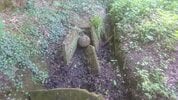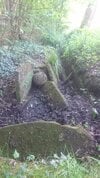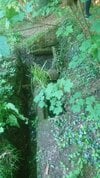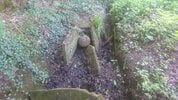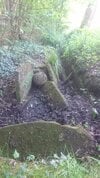Sometimes a bit of digging is required to uncover the prize - the prize of course being an old ram water pump.
If you don’t know what these are have a look at the previous posts.
They’re not always easy to find, so having spent time tracking one down and arrived at nothing but a pile of overgrown rubble you might as well see if there’s anything underneath.
All pictures are phone - I’ve stopped bothering with a camera for this sort of stuff and pack a trowel or small spade instead.
The first example is fairly typical of what happens when following maps about 100 years out of date - there usually isn’t much left.
Four rams were shown along a stream west of Burton-on-Trent, two appearing between 1881 and 1900 with all four present by 1920 - it’s not obvious why there were so many at this location.
In the event, after bashing through moderately intractable woodland one ram had gone completely, there were remains of two others, but the last one was still there and complete, just mostly invisible.
One of the scant remains - a collapsed ram hut, with a tap the only thing visible.


Another with a bit more left, the drive pipe and a couple of valves (that’s actually most of the pump - the most obvious feature, the air tank is the least essential).



The final collapsed hut - doesn’t look promising….

…but after lobbing out bricks and mud the air tank emerged, still attached to the chassis and valves under the mud.


No label left, but it was made by John Blake Ltd (the most common manufacturer in these parts).
The second example is in a valley near Leek, appearing between 1898 and 1925.
Before and after.

Another Blake.


The third is just north of Burnley, appearing between 1890 and 1909 on maps.
The reservoir/filter tank was unusual in that it contained a drum-type filter - and one which is too large to fit through the rather small access door under the leaves on the top.


Downhill at the wrecked hut the air tank was nowhere to be found, and what was left of the pump was hidden under a couple of feet of bricks and mud.


This one has the waste valve before the air tank, a less common arrangement - below is a picture of a similar-looking one made by Blake installed near Blackburn at around the same time.

The fourth was in woods west of Derby, appearing between 1899 and 1920.
Collection/filter tank.

Ram hut with the partially excavated air tank poking above the mud.


This was a curious little pump of unknown make - the only thing written on it was ’no 4’.
There may have been more info on the chassis but it seem to have been deliberately wrapped in plastic sheeting so I left it alone.

The fifth is south of Swadlincote in coal mining country although in general rams don’t seem to be common around defunct collieries.
The first thing I found was the collection/filter tank.

After a bit of searching the sunken ram chamber wasn’t far away.
Before…

…and after partial excavation (another Blake).


The bird, small and tame like a robin, was darting in and out to get the worms that were being uncovered.
Is this a young robin? I’m not too good on birds so couple more pics in case any twitcher on here knows.

I wasn’t really intending to look for the next, near Market Drayton, since it was in a field and there was nothing visible on satellite view.
However the car died while I was looking for something else not far away so I walked over while waiting for the car rescue people to arrive.
The only thing left seemed to be a small (modern) hydro plant making use of the water source.
About two years later I revisited because the map actually shows two rams in this area, appearing sometime between 1900 and 1922.
An air tank was eventually found in a ditch nearby, hidden by nettles and looking at first like a smooth rock in a jumble of sandstone blocks.
No makers plate left, but it was big one, about 3 ft long and extremely heavy.


The final one, in a valley north of Ashbourne, was actually a permission visit.
I usually leave rams near people’s houses alone, but the lay of the land suggested this pump was fed by a pond with quite a large fall of water involved.
Anyway, knocking on the door I asked if it was still there and the owner said it wasn’t but I was welcome to have a look.
A view down the hill from the collection/filter tank - the ram was buried at the far end of the trench.

After excavation - no label, but another Blake.


This one was installed ca 1900 and probably pumped water to a reservoir on a hill whence is flowed down to nearby farms.
I left the area looking like a bomb site, but the owner didn’t seem to mind and was quite interested in the history of his rediscovered pump.
The last one may get a new lease of life, but some of the rams above are in such obscure places they will probably just slowly disappear from view again.
If you don’t know what these are have a look at the previous posts.
They’re not always easy to find, so having spent time tracking one down and arrived at nothing but a pile of overgrown rubble you might as well see if there’s anything underneath.
All pictures are phone - I’ve stopped bothering with a camera for this sort of stuff and pack a trowel or small spade instead.
The first example is fairly typical of what happens when following maps about 100 years out of date - there usually isn’t much left.
Four rams were shown along a stream west of Burton-on-Trent, two appearing between 1881 and 1900 with all four present by 1920 - it’s not obvious why there were so many at this location.
In the event, after bashing through moderately intractable woodland one ram had gone completely, there were remains of two others, but the last one was still there and complete, just mostly invisible.
One of the scant remains - a collapsed ram hut, with a tap the only thing visible.
Another with a bit more left, the drive pipe and a couple of valves (that’s actually most of the pump - the most obvious feature, the air tank is the least essential).
The final collapsed hut - doesn’t look promising….
…but after lobbing out bricks and mud the air tank emerged, still attached to the chassis and valves under the mud.
No label left, but it was made by John Blake Ltd (the most common manufacturer in these parts).
The second example is in a valley near Leek, appearing between 1898 and 1925.
Before and after.
Another Blake.
The third is just north of Burnley, appearing between 1890 and 1909 on maps.
The reservoir/filter tank was unusual in that it contained a drum-type filter - and one which is too large to fit through the rather small access door under the leaves on the top.
Downhill at the wrecked hut the air tank was nowhere to be found, and what was left of the pump was hidden under a couple of feet of bricks and mud.
This one has the waste valve before the air tank, a less common arrangement - below is a picture of a similar-looking one made by Blake installed near Blackburn at around the same time.
The fourth was in woods west of Derby, appearing between 1899 and 1920.
Collection/filter tank.
Ram hut with the partially excavated air tank poking above the mud.
This was a curious little pump of unknown make - the only thing written on it was ’no 4’.
There may have been more info on the chassis but it seem to have been deliberately wrapped in plastic sheeting so I left it alone.
The fifth is south of Swadlincote in coal mining country although in general rams don’t seem to be common around defunct collieries.
The first thing I found was the collection/filter tank.
After a bit of searching the sunken ram chamber wasn’t far away.
Before…
…and after partial excavation (another Blake).
The bird, small and tame like a robin, was darting in and out to get the worms that were being uncovered.
Is this a young robin? I’m not too good on birds so couple more pics in case any twitcher on here knows.
I wasn’t really intending to look for the next, near Market Drayton, since it was in a field and there was nothing visible on satellite view.
However the car died while I was looking for something else not far away so I walked over while waiting for the car rescue people to arrive.
The only thing left seemed to be a small (modern) hydro plant making use of the water source.
About two years later I revisited because the map actually shows two rams in this area, appearing sometime between 1900 and 1922.
An air tank was eventually found in a ditch nearby, hidden by nettles and looking at first like a smooth rock in a jumble of sandstone blocks.
No makers plate left, but it was big one, about 3 ft long and extremely heavy.
The final one, in a valley north of Ashbourne, was actually a permission visit.
I usually leave rams near people’s houses alone, but the lay of the land suggested this pump was fed by a pond with quite a large fall of water involved.
Anyway, knocking on the door I asked if it was still there and the owner said it wasn’t but I was welcome to have a look.
A view down the hill from the collection/filter tank - the ram was buried at the far end of the trench.
After excavation - no label, but another Blake.
This one was installed ca 1900 and probably pumped water to a reservoir on a hill whence is flowed down to nearby farms.
I left the area looking like a bomb site, but the owner didn’t seem to mind and was quite interested in the history of his rediscovered pump.
The last one may get a new lease of life, but some of the rams above are in such obscure places they will probably just slowly disappear from view again.
Last edited:


 :
: